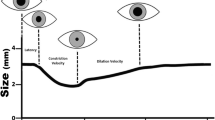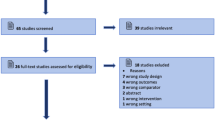Abstract
The aim of this study was to assess the current state of automated pupillometry technology and its application in the neurointensive care unit (neuroICU). We performed a literature search using the PubMed, MEDLINE, and EMBASE databases from database inception through a search end date of October 18, 2018, to identify studies reporting on the use of automated pupillometry in the care of critically ill patients with neurological impairment. Two independent reviewers reviewed all titles and abstracts in two filtering phases. Data were extracted independently. One hundred and forty-one articles/abstracts have been published on the use of automated pupillometry in critical care since inception of the PubMed, MEDLINE, and EMBASE databases. We selected and reviewed 22 full-text articles and 8 abstracts, of which 26 were prospective, 2 were retrospective, and 2 were larger case series. Automated pupillometry increased precision, reliability, and reproducibility compared with the manual pupillary examination; detected subtle and early pupillary changes; detected pupillary changes that indicate a rise, or impending rise, in intracranial pressure detected level of analgesia and depth of sedation; served as a prognostic indicator; estimated the clinical severity of aneurysmal subarachnoid hemorrhage; and served as a noninvasive monitor of response to osmotic therapy. At present, no consensus guidelines exist endorsing routine use of automated pupillometry in the neuroICU. However, an increasing quantity of research supports the usefulness of automated pupillometry in this setting. Further large-scale prospective studies are needed before updated consensus guidelines recommending widespread adoption of automated pupillometry are produced.

Similar content being viewed by others
References
St. Joseph Health. Clinical Guidelines: Pupillometer in Critical Neuro Patients, Use of [Internet]. Mission Viejo, California: 2015 [cited 2018 June 14]. Available from: http://aann.org/uploads/Clinical_Guidelines_Pupillometer.pdf.
Taylor CA, Bell JM, Breiding MJ, Xu L. Traumatic brain injury-related emergency department visits, hospitalizations, and deaths—United States, 2007 and 2013. MMWR Surveill Summ. 2017;66(9):1–16.
Vinciguerra L, Bösel J. Noninvasive neuromonitoring: current utility in subarachnoid hemorrhage, traumatic brain injury, and stroke. Neurocrit Care. 2017;27(1):122–40.
Marklund N. The neurological wake-up test—a role in neurocritical care monitoring of traumatic brain injury patients? Front Neurol. 2017;17(8):540.
Adoni A, McNett M. The pupillary response in traumatic brain injury: a guide for trauma nurses. J Trauma Nurs. 2007;14(4):191–6.
Le Roux P, Menon DK, Citerio G, et al. Consensus summary statement of the International Multidisciplinary Consensus Conference on Multimodality Monitoring in Neurocritical Care: a statement for healthcare professionals from the Neurocritical Care Society and the European Society of Intensive Care Medicine. Neurocrit Care. 2014;21(Suppl 2):S1–26.
Le Roux P, Menon DK, Citerio G, et al. The International Multidisciplinary Consensus Conference on Multimodality Monitoring in Neurocritical Care: a list of recommendations and additional conclusions: a statement for healthcare professionals from the Neurocritical Care Society and the European Society of Intensive Care Medicine. Neurocrit Care. 2014;21(Suppl 2):S282–96.
Le Roux P, Menon DK, Citerio G, et al. The International Multidisciplinary Consensus Conference on Multimodality Monitoring in Neurocritical Care: evidentiary tables: a statement for healthcare professionals from the Neurocritical Care Society and the European Society of Intensive Care Medicine. Neurocrit Care. 2014;21(Suppl 2):S297–361.
Hickey J. The clinical practice of neurological and neurosurgical nursing. 5th ed. Philadelphia: Lippincott Williams and Wilkins; 2003.
Chen JW, Gombart ZJ, Rogers S, Gardiner SK, Cecil S, Bullock RM. Pupillary reactivity as an early indicator of increased intracranial pressure: the introduction of the neurological pupil index. Surg Neurol Int. 2011;2:82.
Meeker M, Du R, Baccheti P, et al. Pupil examination: validity and clinical utility of an automated pupillometer. J Neurosci Nurs. 2005;37(1):34–40.
Emelifeonwu JA, Reid K, Rhodes JK, Myles L. Saved by the pupillometer!—a role for pupillometry in the acute assessment of patients with traumatic brain injuries? Brain Inj. 2018;32(5):675–7.
Kerr RG, Bacon AM, Baker LL, et al. Underestimation of pupil size by critical care and neurosurgical nurses. Am J Crit Care. 2016;25(3):213–9.
Olson DM, Stutzman S, Saju C, Wilson M, Zhao W, Aiyagari V. Interrater reliability of pupillary assessments. Neurocrit Care. 2016;24(2):251–7.
Zafar SF, Suarez JI. Automated pupillometer for monitoring the critically ill patient: a critical appraisal. J Crit Care. 2014;29(4):599–603.
McNett M, Moran C, Janki C, Gianakis A. Correlations between hourly pupillometer readings and intracranial pressure values. J Neurosci Nurs. 2017;49(4):229–34.
NeurOptics—The Leader in the Science of Pupillometry. NeurOptics, 18 August 2018. https://neuroptics.com.
Taylor WR, Chen JW, Meltzer H, et al. Quantitative pupillometry, a new technology: normative data and preliminary observations in patients with acute head injury. J Neurosurg. 2003;98(1):205–21.
Yan S, Tu Z, Lu W, et al. Clinical utility of an automated pupillometer for assessing and monitoring recipients of liver transplantation. Liver Transpl. 2009;15(12):1718–27.
Couret D, Boumaza D, Grisotto C, et al. Reliability of standard pupillometry practice in neurocritical care: an observational, double-blinded study. Crit Care. 2016;13(20):99.
Zhao W, Stutzman S, Olson D, et al. Inter-device reliability of the NPi-100 pupillometer. J Clin Neurosci. 2016;33:79–82.
Larson MD, Muhiudeen I. Pupillometric analysis of the “absent light reflex”. Arch Neurol. 1995;52(4):369–72.
Shoyombo I, Aiyagari V, Stutzman SE, et al. Understanding the relationship between the neurologic pupil index and constriction velocity values. Sci Rep. 2018;8:6992.
Ong C, Kim A, Zafar S, et al. Range of quantitative pupillometry measurements and its association with traditional monitoring metrics in the neuro ICU. Neurocrit Care. 2017;27(2 Suppl 1):(S252-).
Giede-Jeppe A, Koehn J, Gerner S, et al. Serial pupillometer readings predicting intracranial pressure crisis in neurocritical-care patients. Neurocrit Care. 2017;27(2 Suppl 1):(S254-).
Natzeder S, Mack DJ, Maissen G, et al. Portable infrared pupillometer in patients with subarachnoid hemorrhage: prognostic value and circadian rhythm of the neurological pupil index (NPi). J Neurosurg Anesthesiol. 2018. https://doi.org/10.1097/ANA.0000000000000553.
Lukaszewicz A, Dereu D, Gayat E, Payen D. The relevance of pupillometry for evaluation of analgesia before noxious procedures in the intensive care unit. Anesth Analg. 2015;120(6):1297–300.
Rouche O, Wolak-Thierry A, Destoop Q, et al. Evaluation of the depth of sedation in an intensive care unit based on the photo motor reflex variations measured by video pupillometry. Ann Intensive Care. 2013;3(1):5.
Paulus J, Roquilly A, Beloeil H, et al. Pupillary reflex measurement predicts insufficient analgesia before endotracheal suctioning in critically ill patients. Crit Care. 2013;17(4):R161.
Gaillard T, Gergaud S, Grayot C, et al. Can pupillometry diagnose a lack of analgesia prior to nursing in critically ill patients? Intensive Care Med Exp. 2015;3(Suppl 1):A326.
Li D, Miaskowski C, Burkhardt D, Puntillo K. Evaluations of physiologic reactivity and reflexive behaviors during noxious procedures in sedated critically ill patients. J Crit Care. 2009;24(3):472.e9–13.
Wildemeersch D, Gios J, Jorens P, Hans G. Objective nociceptive assessment in ventilated ICU patients: a feasibility study using pupillometry and the nociceptive flexion reflex. J Vis Exp. 2018. https://doi.org/10.3791/57972.
Tamura T, Namiki J, Sugawara Y, et al. Quantitative assessment of pupillary light reflex for early prediction of outcomes after out-of-hospital cardiac arrest: a multicentre prospective observational study. Resuscitation. 2018;131:108–13.
Solari D, Rossetti A, Carteron L, et al. Early prediction of coma recovery after cardiac arrest with blinded pupillometry. Ann Neurol. 2017;81(6):804–10.
Suys T, Bouzat P, Marques-Vidal P, et al. Automated quantitative pupillometry for the prognostication of coma after cardiac arrest. Neurocrit Care. 2014;21(2):300–8.
Beuchat I, Solari D, Novy J, Oddo M, Rossetti A. Standardized EEG interpretation in patients after cardiac arrest: correlation with other prognostic predictors. Resuscitation. 2018;126:143–6.
Behrends M, Niemann C, Larson M. Infrared pupillometry to detect the light reflex during cardiopulmonary resuscitation: a case series. Resuscitation. 2012;83(10):1223–8.
Heimburger D, Durand M, Gaide-Chevronnay L, et al. Quantitative pupillometry and transcranial Doppler measurements in patients treated with hypothermia after cardiac arrest. Resuscitation. 2016;103:88–93.
Sawyer M, Riker R, May T, et al. 287: Very early pupillometry, EEG suppression, and bis data predict outcome 6 hours after cardiac arrest. Crit Care Med. 2018;46(1):126.
Riker R, Sawyer M, Fischman V, et al. 726: Quantitative pupillometry data after adult cardiac arrest an observational study. Crit Care Med. 2018;46(1):349.
Sawyer M, Lucas L, May T, et al. Neurological pupil index predicts neurological outcome early after cardiac arrest: an observational study. Neurocrit Care. 2017;27(2 Suppl 1):(S47-).
Reynolds J, Chassee T, Fankhauser M, Uber A. Abstract 231: preliminary experience with prehospital pupillometry: a prospective, observational study in out-of-hospital cardiac arrest. Circulation. 2018;130:A231.
Suys T, Sala N, Rossetti A, Oddo M. Infrared pupillometry for outcome prediction after cardiac arrest and therapeutic hypothermia. Crit Care. 2013;17(Suppl 2):P310.
Park J, Moon C, Park D, Song S. Clinical utility of an automated pupillometer in patients with acute brain lesion. J Korean Neurosurg Soc. 2015;58(4):363–7.
Ong C, Hutch M, Barra M, et al. Effects of osmotic therapy on pupil reactivity: quantification using pupillometry in critically III neurologic patients. Neurocrit Care. 2018. https://doi.org/10.1007/s12028-018-0620-y.
Kramer C, Rabinstein A, Wijdicks E, Hocker S. Neurologist versus machine: is the pupillometer better than the naked eye in detecting pupillary reactivity. Neurocrit Care. 2014;21(2):309–11.
Papangelou A, Zink E, Chang W, et al. Automated pupillometry and detection of clinical transtentorial brain herniation: a case series. Mil Med. 2018;183(1–2):e113–21.
Ong C, Hutch M, Smirnakis S. The effect of ambient light conditions on quantitative pupillometry. Neurocrit Care. 2018. https://doi.org/10.1007/s12028-018-0607-8.
Phillips S (2018) Phone interview with NeurOptics® representative.
Wilkie AC (2015) Pupillary assessment times [Internet]. Irvine, CA: NeuroSurgical ICU, University of California Irvine Medical Center; 2015 [cited 2018 June 14]. https://neuroptics.com/wp-content/uploads/2017/02/Wilkie-A.-Pupillar-Assessment-Poster-Pres.-2015.pdf.
Olson DM, Stutzman SE, Atem F, et al. Establishing normative data for pupillometer assessment in neuroscience intensive care: the “END-PANIC” registry. J Neurosci Nurs. 2017;49(4):251–4.
Funding
The study received no direct funding.
Author information
Authors and Affiliations
Contributions
SSP and CMM provided substantial contributions to the conception and design of the work and the acquisition, analysis, and interpretation of data. RGN and YMK provided substantial contributions to the analysis and interpretation of data for the work. SSP and CMM drafted and critically revised the work for important intellectual content. RGN and YMK critically revised the work for important intellectual content. SSP, CMM, RGN, and YMK provided final approval of the version to be published. SSP, CMM, RGN, and YMK agreed to be accountable for all aspects of the work in ensuring that questions related to the accuracy or integrity of any part of the work are appropriately investigated and resolved.
Corresponding author
Ethics declarations
Conflict of interest
Raul G. Nogueira declares that he has no conflict of interest related to the topic or work under consideration. Other unrelated disclosures include Stryker Neurovascular (DAWN Trial Principal Investigator—no compensation, TREVO Registry Steering Committee—no compensation, Trevo-2 Trial Principal Investigator—modest; Consultant—modest); Medtronic (SWIFT Trial Steering Committee—modest; SWIFT-Prime Trial Steering Committee—no compensation; STAR Trial Angiographic Core Lab—significant); Penumbra (3D Separator Trial Executive Committee—no compensation); Cerenovus/Neuravi (ENDOLOW Trial Principal Investigator, ARISE-2 trial Steering Committee—no compensation, Physician Advisory Board, modest); Phenox (Physician Advisory Board, modest); Anaconda (Physician Advisory Board, modest); Genentech (Physician Advisory Board—modest); Biogen (Physician Advisory Board—modest); Prolong Pharmaceuticals (Physician Advisory Board—modest); and Allm Inc. (Physician Advisory Board—no compensation). Editor-In-Chief Interventional Neurology Journal (no compensation) and remaining authors declare that they have no conflict of interest.
Human and Animal Rights
This article does not contain any studies with human participants or animals performed by any of the authors.
Rights and permissions
About this article
Cite this article
Phillips, S.S., Mueller, C.M., Nogueira, R.G. et al. A Systematic Review Assessing the Current State of Automated Pupillometry in the NeuroICU. Neurocrit Care 31, 142–161 (2019). https://doi.org/10.1007/s12028-018-0645-2
Published:
Issue Date:
DOI: https://doi.org/10.1007/s12028-018-0645-2




